So, you have read my other articles on how to enjoy and use umeboshi plums for cooking and for home or natural remedies. Here, I will share with you a special recipe, the nishime burdock umeboshi stew.
Some people would even describe this as the ultimate macrobiotic dish! To make it, you have to use the pits of the pickled umeboshi plums. So, make sure to save all the pits just for this recipe.
What is Burdock Root?
The Japanese called it gobo. Also known as gobo in Japanese, burdock root has been used as food and medicine for centuries. People in traditional societies used burdock root in a variety of ways.
Fresh burdock root is eaten as food and used for its medicinal values. Like dandelion root, dried burdock root can be steeped to make gobo tea.
Burdock root, when simmered with umeboshi pits, is a strong yang (as in yin and yang) dish. Hence, it is ideal for those cool autumn or spring days and perfect for any cold wintry days.
Why Burdock Umeboshi Stew is So Good for You?
There are many reasons to make this dish, especially for those of you who tend to often feel cold. For instance, cold in an air-conditioned room, car, or generally feeling cold easily.
Burdock umeboshi stew is nurturing, tonifying, and warming. As autumn creeps in and the herbs and plants in my garden are dying, this dish is one of my favorites, especially when paired with pressured cooked brown rice.
Despite its tonifying and strengthening effects, the burdock umeboshi stew also helps to detoxify your body. Burdock root helps to purify the blood, detoxify and strengthens the lymphatic system. Thus it enables the body to fight and ward off disease.
Due to its anti-inflammatory properties, burdock root helps to improve arthritic conditions. It can promote speed healing. Thus it can heal various skin conditions, such as acne, eczema, and psoriasis.
Burdock root also works as a natural diuretic. It has the ability to defend the body against diabetes. Some studies indicated that this versatile, earthy-tasting root can help to combat cancer.
As you can imagine, with its many healing benefits, burdock root is a staple food in traditional societies. It is an important root vegetable used in traditional recipes and macrobiotic cooking.
Burdock Umeboshi Stew Variations
This dish is simple and relatively easy to prepare. However, there are two variations to cook this scrumptious dish. You can either cook the root vegetable nishime or kinpira style.
Nishime, a Japanese word, refers to waterless cooking. This way of cooking the burdock root requires very little water and no oil. Instead, the roots are simmered with little water on low flame until the liquid almost evaporates.
Nishime Burdock Umeboshi Stew Recipe
Here’s how to prepare the burdock umeboshi stew—nishime style.
You need only 3 ingredients and 7 steps. Here is the recipe.
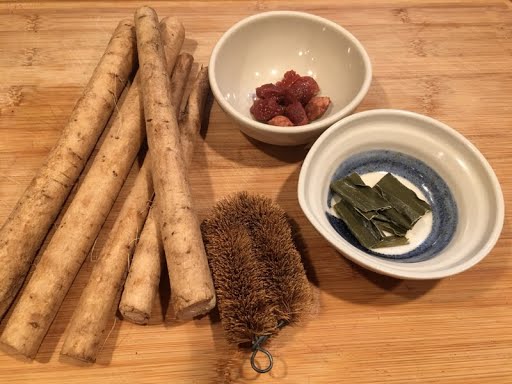
What You Need
- 300 grams burdock root (or about 40 inches long of the root)
- 5 or more umeboshi pits
- 2-3 inches strip kombu seaweed
Instructions
- Wash and scrub burdock root with a bristle brush. Do not peel off the skin.
- Cut the burdock into chunks of about one and half to two inches long. Slice thicker sections of the roots into half.
- Put the kombu seaweed at the bottom of the pot. Then add the burdock chunks and place the umeboshi pits on top of the burdock.
- Add enough water to cover ingredients.
- Cover pot with a drop lid, if possible. Or simply choose a pot with a heavy lid.
- Start with high flame to bring the water to a boil. Then reduce to low flame. Leave the burdock to simmer for about 30-35 minutes, or until the roots are tender.
- Continue to simmer till most of the liquid evaporates.
Serve your nishime burdock umeboshi stew with hot pressured-cooked brown rice. Enjoy your simple meal with a small bowl of miso soup, or a cup of kukicha or bancha tea.
Notes on Nishime Burdock Umeboshi Stew
Make sure that you use enough pits so that the burdock roots are not too bland. If you don’t have enough pits, you can add a few small pieces of the plum flesh.
You can also make the kombu-dashi stock beforehand and store it in the refrigerator for this and other dishes.
I use a 2-Qt. round covered cast iron pot. So, there’s no need to use a drop lid, or otoshibuta in Japanese. You can also use a pressure cooker to shorten the cooking time.
Where to Buy the Ingredients?
These days fresh burdock root and kombu seaweed are readily available in most Asian stores.
However, it may be more difficult to source good quality umeboshi plums.
I choose to use organic umeboshi plums and have used Eden, Mitoku, and Muso brands. You can buy these organic plums from health foods stores. Alternatively, you can buy organic umeboshi plums from Amazon and other online stores.
However, the plums usually come in small packets and they are quite pricey.
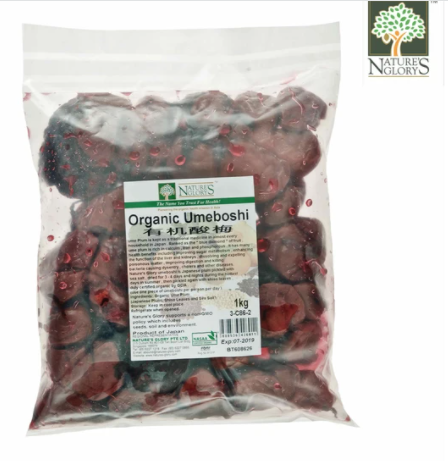
If you plan to use umeboshi plums regularly, it is best to buy in bulk. Currently, the only place I know that sells organic umeboshi plums in one-kilogram (2.2 pounds) packet is Nature’s Glory in Singapore.
For over two decades, Nature’s Glory is my go-to place to buy organic umeboshi plums in bulk size. Whenever I visited Asia, I’d make it a point to stop over at the island city for these plums!
I think you can buy Nature’s Glory umeboshi plums in bulk from their online store, as this item is available for international shipping. For more information, send them an email.
Takeaway
Burdock umebosh dish is ideal, if you are planning to detox and strengthen your body at the same time. Moreover, burdock root contains a lot of fiber.
It is also rich in low-calorie nutrients. At about 72 calories per 100 grams of burdock root, this root vegetable is ideal for the weight-conscious.
I prefer the burdock umebosh stew—nishime style, as it’s oil-free, rather than the kinpira version.
Check out both cooking styles and let me know which version you prefer.
Feel Inspired and Enthused?
Please check out more recipes with umeboshi plums that I’ll be posting each week.
- Cucumber with Umeboshi
- Chilled Tofu with Umeboshi
- Miso Soup with Umeboshi
- Ume Ochazuke
- Kinpira Style Burdock Umeboshi Stew (cooked with plum pits)
Here are my other articles on umeboshi plums that you may like to check out.
- Amazing Umeboshi Plums: Ancient Power Food
- 9 Ways to Enjoy Umeboshi Plums
- 10 Ways to Use Umeboshi Plums
- Kinpira-style Burdock Umeboshi Stew
 Dr. Margaret TreyAuthor, Researcher & Wellness Advocate
Dr. Margaret TreyAuthor, Researcher & Wellness Advocate
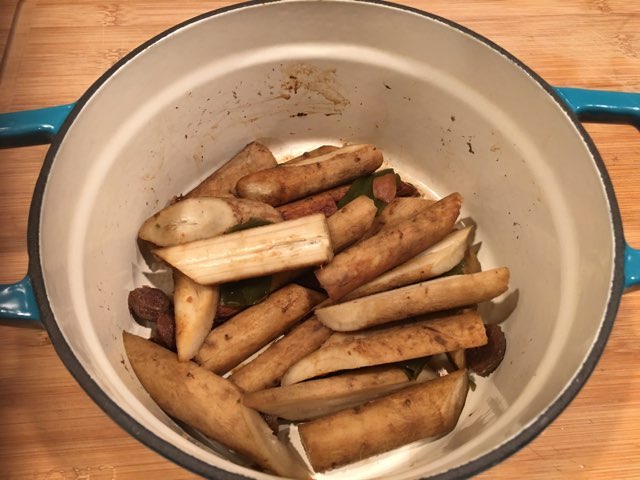

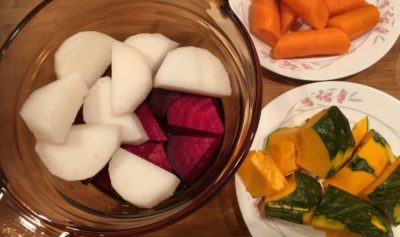
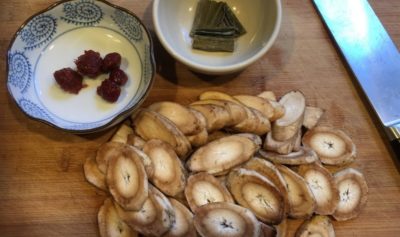
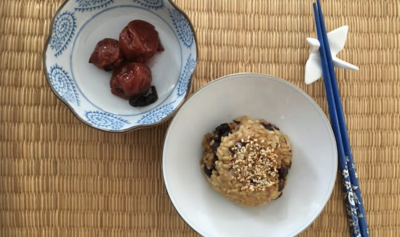
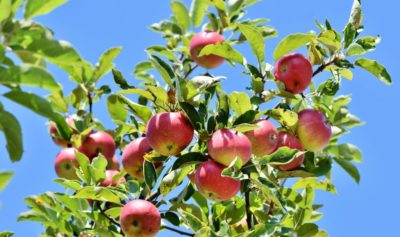

Inspiring!
Thank you.